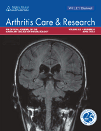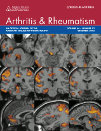ACR:Gaenslen’s实验阳性的RA患者疾病活动度高
2013-05-28 ACR dxy
Gaenslen's实验(GT)阳性是掌指关节(MCP)或跖趾关节(MTP)侧压疼痛的特征。来自奥地利维也纳医科大学的TANJA WIESINGER等人进行了一项研究,目的是评价GT阳性相关的因素和探讨GT阳性和GT阴性患者的疾病活动度差异。研究结果在线发布在2013年4月的《关节炎护理及研究》(Arthritis Care & Research)杂志上。作者发现,GT主要与MCP和MTP
Gaenslen's实验(GT)阳性是掌指关节(MCP)或跖趾关节(MTP)侧压疼痛的特征。来自奥地利维也纳医科大学的TANJA WIESINGER等人进行了一项研究,目的是评价GT阳性相关的因素和探讨GT阳性和GT阴性患者的疾病活动度差异。研究结果在线发布在2013年4月的《关节炎护理及研究》(Arthritis Care & Research)杂志上。作者发现,GT主要与MCP和MTP关节疼痛相关,能提示RA患者中到重度疾病活动。
GT是类风湿关节炎(RA)患者门诊就诊时的一项常规检查。研究共纳入229位GT阳性的患者(GT阳性组),并针对GT阳性组设置了GT阴性组(n=222)。两组在性别、年龄、病程、类风湿因子(RF)阳性等方面相匹配。研究者对疾病活动积分、肿胀关节数和疼痛关节数、患者自我整体评估、医生整体评估、晨僵、残疾评估,血清急性期反应物、RF和抗瓜氨酸蛋白抗体水平进行评估和回归分析,采用回归模型对GT阳性和GT阴性组进行比较。
研究结果如下,GT阳性组的所有的临床变量,包括疾病活动积分、肿痛关节数目和残疾评估均显著高于GT阴性组。而且,GT阳性组中仅有少数患者获得缓解和低疾病活动度。GT阳性与关节压痛(32或者28个关节计数)强相关(r>0.5)。近端指间关节、MCP和MTP疼痛似乎均可能出现GT阳性,但是一个以上的MCP/MTP疼痛能更好的解释GT阳性。
研究发现,GT主要与MCP和MTP关节疼痛相关,能提示RA患者中到重度的疾病活动。

Compression test (Gaenslen's squeeze test) positivity, joint tenderness, and disease activity in patients with rheumatoid arthritis.
OBJECTIVE
Gaenslen's test (GT) positivity is characterized by tenderness upon lateral compression (squeezing) of the metacarpophalangeal (MCP) or metatarsophalangeal (MTP) joints. We aimed to assess the factors related to a positive GT and to explore differences in disease activity between GT-positive and -negative patients.
METHODS
The GT was performed routinely in outpatients with rheumatoid arthritis (RA). In total, 229 patients had a positive GT (GT-positive group). To this group, we matched a GT-negative group (n = 222) comparable in sex, age, disease duration, and rheumatoid factor (RF) positivity. Disease activity scores, swollen and tender joint counts, patient pain and global assessments, evaluator's global assessment, morning stiffness, disability assessments, acute phase reactants, RF, and anti-citrullinated protein antibody levels were assessed and used for correlation analyses. A comparison between the GT-positive and -negative groups was performed and a regression model was calculated.
RESULTS
All clinical variables, including disease activity scores, joint counts, and disability assessments, were significantly higher in the GT-positive group than the GT-negative group. Also, there were significantly fewer patients in remission or with low disease activity in the GT-positive group. GT positivity correlated most strongly (r > 0.5) with joint tenderness (32- and 28-joint counts). Tender proximal interphalangeal, MCP, and MTP joints appeared mostly responsible for a positive GT, but more than 1 MCP/MTP joint had to be tender to explain a positive GT.
CONCLUSION
The GT is related primarily to tenderness in MCP and MTP joints and signifies a moderate to high disease activity among patients with RA.
本网站所有内容来源注明为“梅斯医学”或“MedSci原创”的文字、图片和音视频资料,版权均属于梅斯医学所有。非经授权,任何媒体、网站或个人不得转载,授权转载时须注明来源为“梅斯医学”。其它来源的文章系转载文章,或“梅斯号”自媒体发布的文章,仅系出于传递更多信息之目的,本站仅负责审核内容合规,其内容不代表本站立场,本站不负责内容的准确性和版权。如果存在侵权、或不希望被转载的媒体或个人可与我们联系,我们将立即进行删除处理。
在此留言










#疾病活动#
66
#活动度#
65
#疾病活动度#
75
#SLE#
86
#ACR#
59